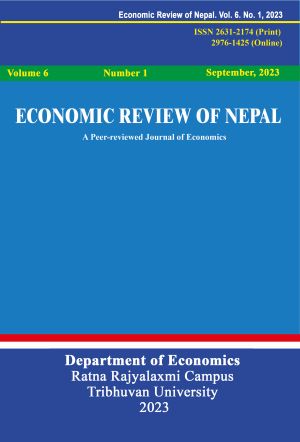Unraveling the Effect of Remittance on Nepal's Agricultural GDP
DOI:
https://doi.org/10.3126/ern.v6i1.67968Keywords:
migrants, international, labour market, economic development, consumptionAbstract
The objective of this study is to analyze the impact of remittance on Nepal's agricultural GDP. It employed a causal-comparative research design to analyze the impact of remittance on Nepal's agricultural GDP based on panel data covering the periods from 2000 to 2022. Remittances play a major role in Nepal's economy, contributing significantly to its overall growth. Nepal is ranked fifth in the world when it comes to remittance as of percentage of GDP is 26.6 percent in 2023. The coefficient for remittance to GDP was -0.571, with a significant value of t—5.766 (p<0.001), indicating that remittances had a negative impact on the contribution of agriculture, forestry, and fishing to GDP. These findings show that an increase in remittance leads to a significant and consistent reduction in the proportion of GDP attributed to agriculture, forestry, and fishing. The remittance is the result of labour migration to the international labour market. If this trend continues, then Nepal is bound to face the acute shortage of labour in the near future and thereby reducing the use of arable land. This critical fact should also be taken into consideration by the Government authority and policymakers.
Downloads
Downloads
Published
How to Cite
Issue
Section
License
Copyright (c) 2023 Department of Economics, Ratna Rajyalaxmi Campus

This work is licensed under a Creative Commons Attribution-NonCommercial 4.0 International License.
This license enables reusers to distribute, remix, adapt, and build upon the material in any medium or format for noncommercial purposes only, and only so long as attribution is given to the creator.




